- Quick Read
- Deep Read ( 12 Min. )
In Today’s Issue
- Grace in grief: Ukrainians find dignity in honoring those they’ve lost
- Murder in Moscow: The murky politics behind a political killing
- How women are banding together to change Japanese politics
- Tiger births and Benin Bronzes: Restorations of nature and art
- Audiobooks to thrill, delight, and spread hope
Monitor Daily Podcast
- Follow us:
- Apple Podcasts
- Spotify
- RSS Feed
- Download
TODAY’S INTRO
A new school year brings a fresh start – and a call for kindness
 Ali Martin
Ali Martin
Millions of American kids are back in school this month, including my own – a seventh grader and a high school junior.
For me, this new school year comes with a sense of relief. At our annual orientation, Superintendent Evan Anwyl made a few welcome announcements: Children are back in class with only a few COVID-19-related protocols. Masks are optional. Parents are allowed on campus this year, which means we can attend performances and help out in classrooms. I missed that last year.
But the most touching moment was when Mr. Anwyl revealed this year’s theme: kindness. Simple, actionable kindness.
Mr. Anwyl chose kindness for a few reasons: On a broad scale, he says that we’re coming out of pandemic schooling, still reckoning with a hostile political environment, and seeing an escalation of meanness on social media and in person.
A widely reported CDC study released earlier this year shows that sadness, hopelessness, and plans for suicide are all up among students.
At our school, in particular, Mr. Anwyl explained via email, there has been “an uptick in kids simply being quicker to anger and, more importantly, expressing very valid emotions, such as anger, disgust, shame, etc., in unhealthy ways.”
Kindness, he said, helps students find “constructive ways of handling such emotions.”
He closed with something that gave me pause: “We don’t have bad kids or bad families. I want to make that perfectly clear. We have both kids and families that need more encouragement and education to gain and use more positive tools of interaction and being.”
Releasing someone from a predetermined end is the kindest act I can imagine.
Share this article
Link copied.

Help fund Monitor journalism for $11/ month
Already a subscriber? Login

Monitor journalism changes lives because we open that too-small box that most people think they live in. We believe news can and should expand a sense of identity and possibility beyond narrow conventional expectations.
Our work isn't possible without your support.
A deeper look
Grace in grief: Ukrainians find dignity in honoring those they’ve lost
For Ukrainians, the absence of loved ones killed in war is a constant presence. Their remembering and honoring reveals grace in grief, and an essential humanity that defies the barbarism of the conflict.

The anguish of tens of thousands of people who have lost loved ones to the war permeates Ukrainian culture. The victims – siblings and spouses, parents and children – shadow the living in memory, their deaths brutal, premature, needless. For the families left behind, their absence is a constant presence.
The individual tragedies at once reflect and magnify a nation’s torment in a war that has killed an estimated 5,600 Ukrainian civilians and 9,000 soldiers.
Yet in another sense, even as each day inflicts more suffering, the resolve of the bereaved to endure offers further evidence of the country’s collective will. It is reflected in myriad ways: the mother who creates a scholarship to memorialize her soldier son, the twin whose civilian brother was shot by Russian troops recognizing that “I cannot bring my brother back, but I can share his heart.”
Their private efforts to remember and honor the dead reveal a grace born of grief, an essential humanity that defies the barbarism unleashed by Russian President Vladimir Putin.
Yana Shklyaruk, a 21-year-old widow and mother of an infant, crystallizes a nation’s resolve in her assessment of the loss of her husband: “Russia took him from me. But Russia cannot take who he was from me.”
Grace in grief: Ukrainians find dignity in honoring those they’ve lost
Nothing in life separated the twin brothers until the violence of war erupted. Nikolai and Misha Kovalenko, born 15 minutes apart on Nov. 19, 1960, shared a bond that deepened as they grew from boys to men, from husbands to fathers to grandfathers. Their parents raised them in northern Ukraine and instilled an unwavering allegiance to a country then under the Soviet Union’s control. Conscripted into the Red Army, they served together in the same unit in Hungary, and after returning home in 1985, the brothers settled near each other in the Kyiv suburb of Bucha.
They followed parallel paths in the ensuing decades. Each man married, started a family, and found a career – homebuilder for Nikolai, security system technician for Misha. Nearing retirement, they still spoke almost every day, even if only for a minute or two by phone. The ritual reassured the twins that life was as it had always been.
The future diverged from the past when Russia invaded Ukraine on Feb. 24. Nikolai escaped west to the Lviv region with his wife and two sons. Misha stayed back with his wife and daughter. The fighting in Bucha intensified, and with Russian troops turning the city into a killing field, the family tried to flee by car on March 5.
Misha had driven about 2 miles, past ruined high-rises and grocery stores, when he hit a Russian checkpoint on Yablonska Street. He stopped before the barricades and stepped out with his hands up. The soldiers opened fire. His body fell.
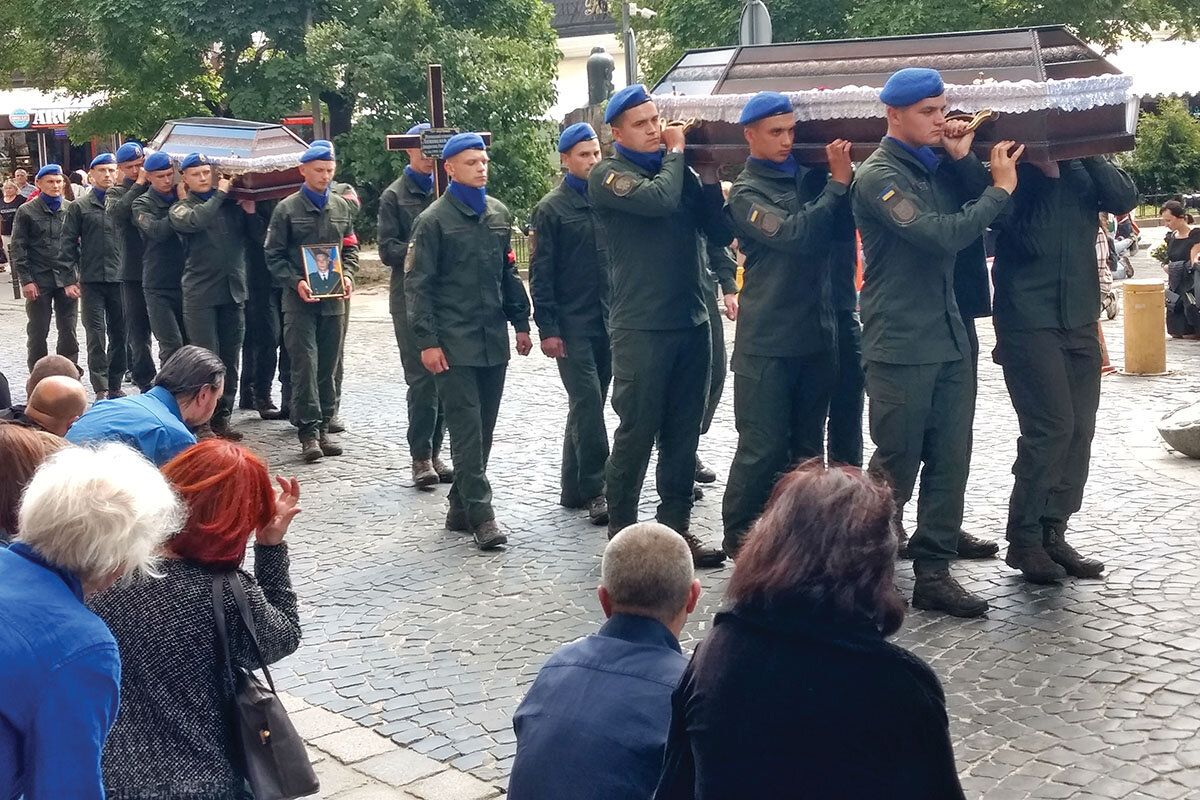
His wife was shot in the leg as she and her daughter ran from the car. Both women survived. Misha’s body, clad in the blue parka he had donned that winter morning, remained beside the road for 29 days before Ukrainian troops liberated Bucha and the dead could be retrieved.
“I will never feel the same,” Nikolai says. He stands next to the wooden cross that marks his brother’s grave in the city cemetery, where more than 400 residents killed by Russian troops are buried. A memorial wreath of red, pink, and white flowers nestles below a framed photo of Misha sitting at a table behind his home, looking at peace.
It is late June, and sunshine collides with dark clouds in the afternoon sky. Nikolai tugs at the bill of his cap and lowers his eyes. “Part of me is no longer here.”
His words capture the anguish of tens of thousands of Ukrainians who have lost loved ones to the war. The victims – siblings and spouses, parents and children – shadow the living in memory, their deaths brutal, premature, needless. For the families left behind, their absence is a constant presence.
The individual tragedies at once reflect and magnify a nation’s torment in a war that has killed an estimated 5,600 Ukrainian civilians and 9,000 soldiers. Yet in another sense, even as each day inflicts more suffering, the resolve of bereaved citizens to endure offers further evidence of the country’s collective will. Their private efforts to remember and honor the dead reveal a grace born of grief, an essential humanity that defies the barbarism unleashed by Russian President Vladimir Putin.
Misha was one of several Bucha residents killed on Yablonska Street in the first weeks of the invasion. The images of the slain civilians – some lying beside the bicycles they were riding when shot – horrified the world and laid bare Russia’s intentions to terrorize the populace. Nikolai’s thoughts turn again and again to his brother’s decision to raise his hands.
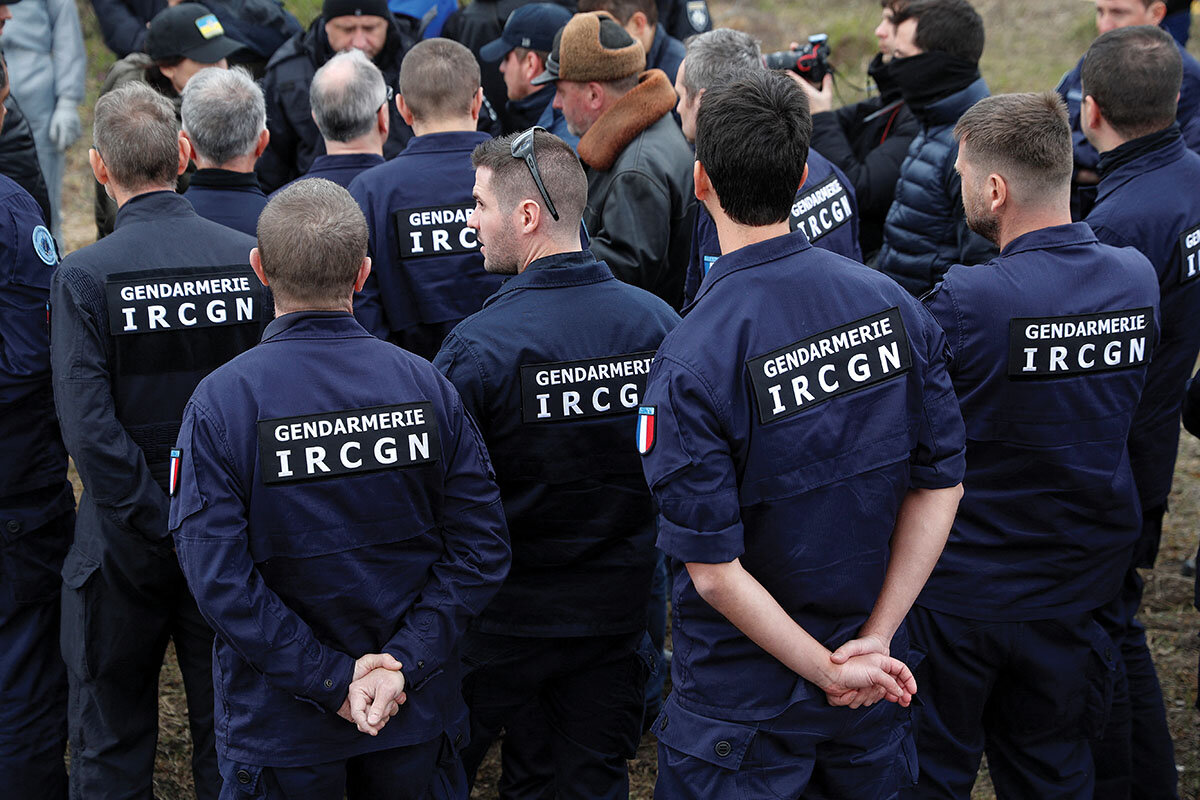
“I think what he did was very brave,” Nikolai says. He interprets Misha’s act as a display of nonviolent resistance rather than surrender, and one rooted in an ethos they learned in childhood. “Our parents taught us that Ukraine was not part of Russia and we ourselves were not Russian. What he did – it was a way of saying, ‘I will never belong to you.’ He lived and died as a Ukrainian.”
His death opened a void within Nikolai, who still catches himself dialing Misha’s phone number. He finds a measure of solace in the belief that his twin brother’s spirit watches over him. He recounts a fraught exchange with a family member who accosted him after he returned to Bucha in April. “Why do you get to live instead of Misha?” she asked.
In his telling, he responded with a calm compassion that, in retrospect, he views as his brother’s more than his own. “I understand your pain because I miss him, too,” Nikolai told her. The words defused her anger, and the two embraced.
He gestures at Misha’s photo on the cross. “I cannot bring my brother back,” he says. “But I can share his heart.”
A similar desire sustains Nataliya Lipska through her sorrow. Her younger brother, Olexsiy Tarasyev, joined Ukraine’s volunteer territorial defense force in Lviv the day after Russia invaded. A chemist by trade, he served as a combat medic in a unit deployed to the eastern city of Kharkiv.
The siblings last spoke on June 12 over a spotty cell connection. “Hello, sister,” he said. “I’m good.” The call dropped, and within an hour, an artillery strike had killed him.
Three weeks after his death, Ms. Lipska sits in a cafe a mile from his grave in Lviv, her voice a pained whisper as she recites his final words through tears. “I still cannot say he was my brother. It should be is,” she says.
She describes Olexsiy, with his large, soft eyes and quiet voice, as principled, determined, and possessed of a distinctive code of propriety. He spurned a lieutenant’s commission in the armed forces after graduating from university in Lviv, refusing to cut off his ponytail and trim his beard – policies he regarded as pointless.
Almost two decades later, when Russian troops crossed into Ukraine, he seized the chance to fulfill his military duty and defend his country.
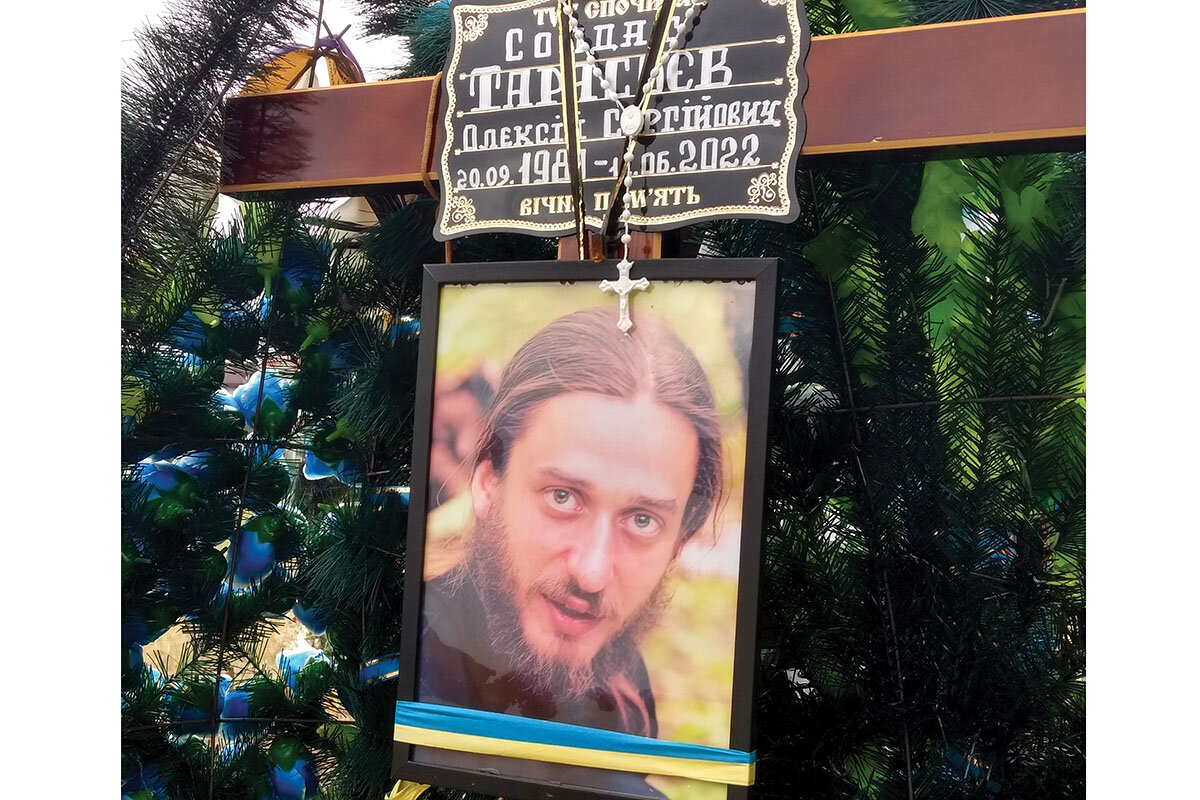
“I wasn’t happy when he signed up, but I understood,” Ms. Lipska says. She smiles at the thought of him conceding to “a little” pruning of his hair and beard as a condition of wearing the uniform. “I’m proud of Olexsiy. He had the courage to step forward for Ukraine.”
Ms. Lipska, the director of a charity in Lviv that provides support to children with cancer and their families, took on a second mission after he volunteered to fight. She assists a local organization that gathers medical supplies and first-aid kits to send to front-line troops. She continues the work as an homage to her fallen brother.
“He gave his life to his country,” she says, pausing to wipe away more tears. “So I am devoting mine.”
Petro Korol walks along the sandy rows of beflowered graves in the Irpin city cemetery as he narrates stories of war. Early in the invasion, Russian troops ravaged the Kyiv suburb that borders Bucha, killing more than 300 residents. The heavy toll forced Mr. Korol, the cemetery’s manager, to open a vast new section of the grounds.
He stops beside the burial plot of Larisa Osipov and her husband, Vadym. Mr. Korol recalls her warm smile and kind manner as the longtime director of a local kindergarten that he and generations of children attended. Russian soldiers shot the couple dead in their backyard on March 24, four days before Ukrainian forces reclaimed the city.

Mr. Korol moves toward a pair of wooden crosses above the graves of a childhood friend’s parents. Nadiya Myakushko and Volodymyr Cherednichenko used to invite young Petro and his mother and father to their home for gatherings. A Russian armored vehicle fired on the house and killed the couple. Two graves away lies Pavlo Malyuk, the father of one of Mr. Korol’s friends from university. The trio gathered at a local cafe now and then to drink coffee and discuss the world. Russian soldiers gunned him down outside his home.
Composed and soft-spoken, Mr. Korol learned the details of their deaths while he and a small team of workers helped collect bodies across Irpin starting in mid-March. They wore armored vests and ballistic helmets as fighting raged between Ukrainian and Russian troops. He calls the task less arduous than another aspect of his job.
“The hardest part is listening to the sadness of the people who have lost someone,” he says. He gently taps the metal cross on Mr. Malyuk’s grave as he once might have patted the older man’s shoulder. “Their words go through my soul.”
Mr. Korol and his wife decided in March that she would evacuate to Poland with their two preteen sons. An order of martial law from Ukrainian President Volodymyr Zelenskyy requires men ages 18 to 60 to stay to defend the country. As much as he misses his family, Mr. Korol, a member of Irpin’s territorial defense force, insists he would have remained in the country without the president’s edict.
He stays as a tribute to all those he knew who have died, to console mourning families in their darkest moment, to preserve Ukraine’s independence so that the young inherit a brighter future. “I am here because I want the war to be over,” he says. “That is what will end the suffering, and that is how we will live free.”
The widow and her toddler son returned to Irpin on a June night four months after fleeing to Poland. The next afternoon Yana Shklyaruk stands before the grave of her late husband, Ilya, for the first time.
He had hugged mother and child goodbye on a train platform in Kyiv on March 2. Six days later, he vanished. Weeks passed before her father found Ilya’s name on a list of the dead at the morgue.
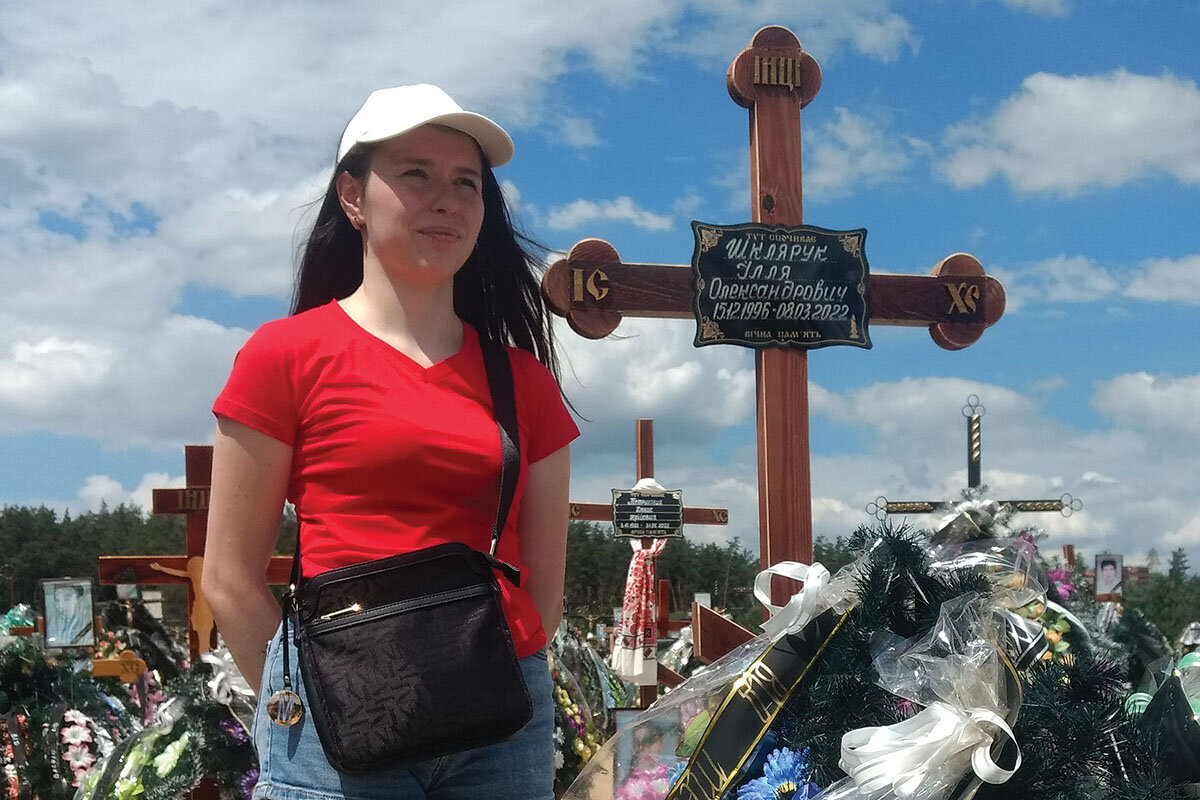
“This man did nothing and he was killed,” Ms. Shklyaruk says. Her voice, as impassive as her face, conveys the numb disbelief of the brokenhearted. She wears a baseball hat, jean shorts, and tennis shoes, and at age 21, she understands that war has cleaved her life. Before has turned into after, clarity into uncertainty. “What happened will never make sense. His own son will not remember him.”
She met her future husband at a cafe in 2018 when Ilya, a few years older and tall, lean, and dark-haired, approached and asked for her phone number. Her initial wariness receded after a couple of dates, and they married the following year. She holds up her phone to show wedding photos. Their smiles radiate the promise of tomorrow.
Ms. Shklyaruk, confronted by the emptiness wrought by Ilya’s death, holds tight to his memory. She vows that their son, Serhiy, will know his father, his warmth and charm, his selfless concern for others. During the war’s first days, Ilya drove neighbors to safety, acting as a one-man evacuation crew. Russian troops shot him dead inside his car.
“I will honor him in the way I raise our son. His spirit will always be alive inside us,” she says. A bookkeeper at an insurance firm with offices outside Ukraine, she will decide in the coming months whether to stay in Irpin or work for the company abroad. Her lasting devotion to Ilya fortifies her against the confusion ahead.
“Russia took him from me,” she says. “But Russia cannot take who he was from me.”
Residents of Bucha sought spiritual comfort from archpriest Andriy Galavin as Russian forces bombarded their homes and killed their neighbors in February and March. He urged parishioners at the Church of St. Andrew to aid each other and resist the impulse for revenge. He wonders if he sounded as diffident to them as he seemed to himself.
“Everything from that time is blurry. I was in shock,” he says, talking on a morning in late June outside the Orthodox church. Sunshine shimmers off its golden domes above towering white walls pockmarked with bullet and shrapnel holes. “There was a very high level of grief for all of us.”
A line of wooden fence posts behind the church demarcates a dirt expanse where workers dug a temporary mass grave earlier in the war. In March, with the morgue at capacity and Russian forces blocking the route to the cemetery, city officials asked Father Galavin for permission to bury dozens of bodies in a trench on church property.
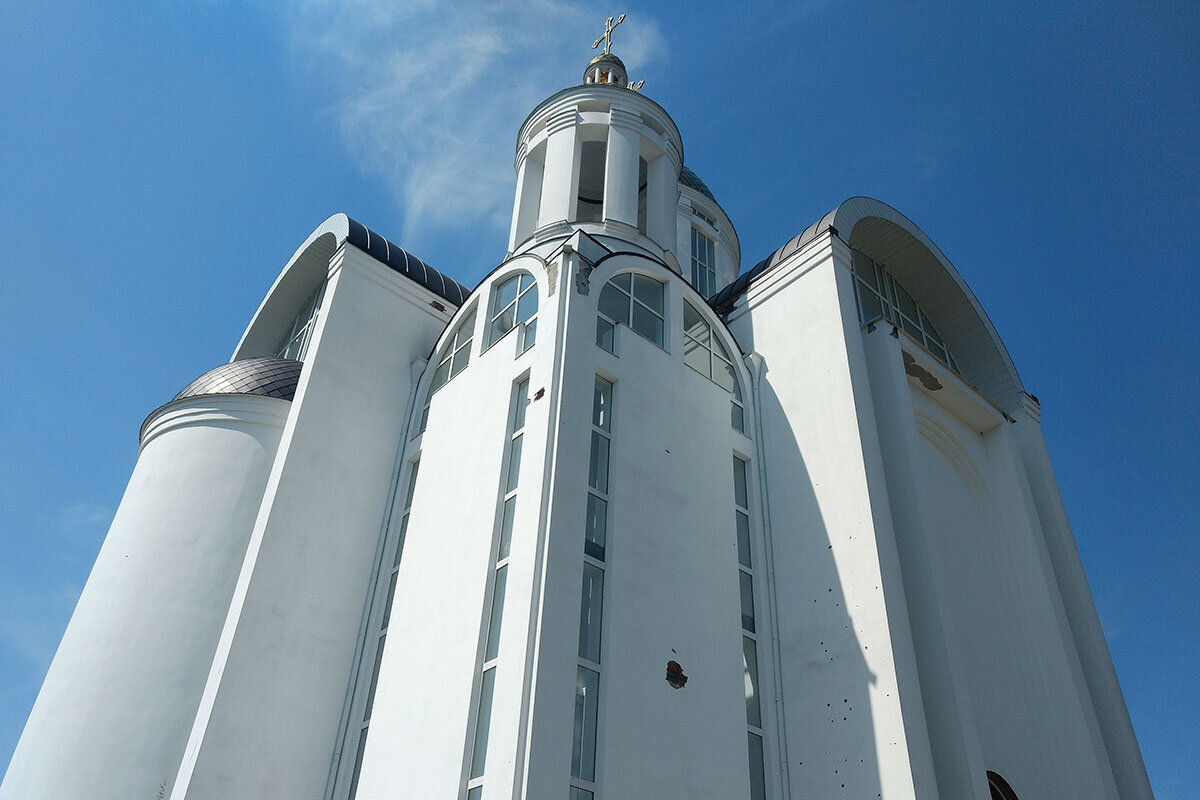
The deceased were later exhumed and identified for formal burial after the Ukrainian army took back Bucha. Several of the victims had belonged to the congregation. Father Galavin, as distressed as his parishioners, struggled to make sense of the atrocities. “There were so many terrible things,” he says. “I couldn’t understand what was happening.”
Large photographs that document the human toll of the siege of Bucha lean on easels inside the church’s bright white, mostly empty nave. Father Galavin hosts visiting dignitaries in the space, guiding them past the images as he describes the entwined tragedies of city and church. On this day, he welcomes Moldovan President Maia Sandu and a coterie of Ukrainian officials.
“Speaking about the horror of war is a responsibility that nobody in Ukraine expected or wanted,” he says before the group arrives. “But it is important that those who come here know what happened so that it is not forgotten.”
War can induce a crisis of faith. Father Galavin encourages congregants to remember the resilience, unity, and compassion they showed in the face of inhumanity. He invokes their shared trauma in his sermons to remind them of their courage and capacity to endure.
“We have seen the worst that people can do to us,” he says. “We have also seen the best that we can do for each other. We ask God to give us the strength to persevere.”
“I survived.” Artem Dymyd uttered his last words in June after a Russian artillery strike on his army unit near the southern city of Kherson. The combat medic who tried to save him found it “impossible” that the barely conscious soldier could speak, let alone form a coherent phrase.
The fact held less surprise for his mother. Ivanka Dymyd knew her son burned with righteous indignation toward injustice in general and Russia in particular. “Our family now lives by these words,” she says, sitting in her home in Lviv in early July. “They are a comfort for us.”
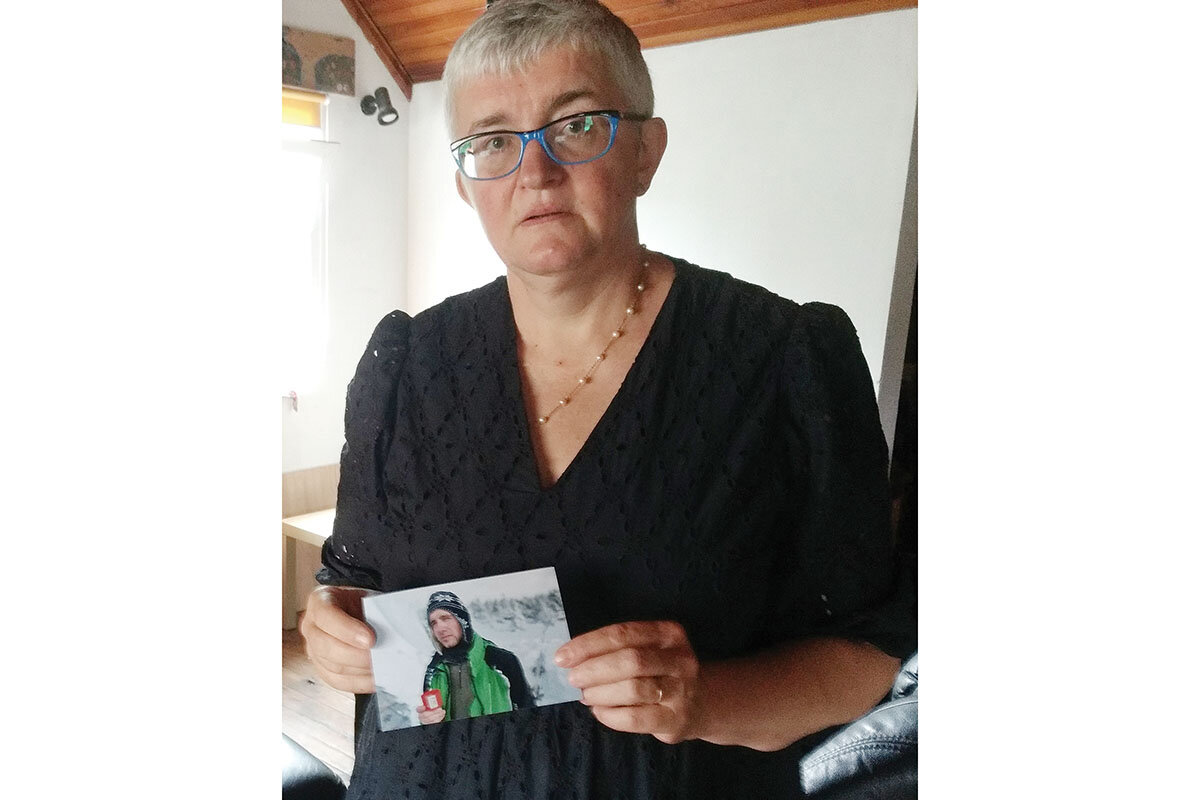
Ms. Dymyd, who with her husband, Mykhaylo, raised four children, has laid out photos that span from Artem’s birth on July 4, 1994, to a hiking trip last fall. The lush, somber music of Hans Zimmer, his favorite composer, plays on her computer. “He is very much still with us,” she says. “You feel his presence.”
Adventure and purposeful defiance defined her son’s 27 years. He visited dozens of countries on his motorcycle, climbed Mount Kilimanjaro, and earned local fame for his exploits as a skydiver and BASE jumper. In 2013, still in his teens, he traveled to Kyiv to join the massive protests against then-
President Viktor Yanukovych. Months later, after Mr. Yanukovych’s ouster, he rushed to join the fight against Russian-backed militants who had seized a portion of eastern Ukraine.
His two years on the front lines there changed him. Ms. Dymyd, an artist in western Ukraine well known for her paintings of religious icons, recalls that he came home with a profound sadness concealed beneath his familiar exuberance. “The pain, the struggle, the loss of friends – he kept that inside,” she says. “He wanted to bring light to people.”
In that spirit, the family will establish a scholarship in Artem’s name at the Lviv university he attended. Ms. Dymyd wants to celebrate his life rather than dwell on his death. Her mind turns away from him succumbing on a distant battlefield. She chooses instead to remember their last embrace in February as he prepared to return to war.
“When we hugged, he felt very warm,” she says. “It was almost like he was dissolving into me.”
In her thoughts, in her dreams, in her every breath, he survives.

Murder in Moscow: The murky politics behind a political killing
The pro-war activist slain in a car bomb in Moscow likely was targeted as a Kremlin proxy. But for most Russians, the unknowns surrounding her killing may have clouded any political message.

- Quick Read
- Deep Read ( 4 Min. )
There seems little doubt that the slaying in Moscow of right-wing, pro-war activist Daria Dugina was fallout from the Ukraine war, designed to create a stir among the Russian public. But there are divergent theories over who planted the car bomb that killed her and why.
She was a publicist and TV personality in her own right, but the true target was more likely her father, ultranationalist philosopher Alexander Dugin. He is the author of the “Eurasianist” ideology, which seeks to reconstitute the Russian Empire capable of challenging the West.
Russia’s FSB security service blamed a Ukrainian agent for the killing, naming the suspect and detailing her movements with remarkable speed and precision, considering its response to many other high-profile political killings.
Ukraine denies any involvement. Some suggest an FSB “false flag” attack, aimed at justifying an escalation of the war against Ukraine. A former Russian parliamentarian now in exile in Kyiv claimed the hit was carried out by indigenous Russian anti-Kremlin partisans.
“I would take all these explanations being offered with a lot of skepticism,” says Nikolai Petrov, a Russian affairs expert with Chatham House in London. “They all seem badly flawed. They are tailored mainly to be ammunition in the information war that’s going on, rather than honest attempts to inform people.”
Murder in Moscow: The murky politics behind a political killing
The funeral in Moscow Tuesday for Daria Dugina, the right-wing, pro-war activist who was killed in a car bombing Saturday, attracted hundreds of grim-faced mourners.
Yet it seemed almost palpably overshadowed by anxieties over the course of Russia’s 6-month-old war in Ukraine and the public’s staying power as the costs continue to mount.
There seems little doubt that the slaying of Ms. Dugina was in some manner fallout from the war, though there are several divergent theories over who planted the car bomb that killed her and why.
She was a prominent publicist and TV personality in her own right, and recently an enthusiastic promoter of the war. But the true target was more likely her father, ultranationalist philosopher Alexander Dugin, a fringe figure on Russia’s political right and a sometime critic of President Vladimir Putin. Mr. Dugin was meant to be in the car with his daughter that night, but changed his mind at the last moment.
Mr. Dugin is the author of the “Eurasianist” ideology, which offers a rationale for the reconstitution of the Russian Empire by gathering together the Russian-speaking lands of Europe and Asia, and at their core, Russia, to create a superpower capable of challenging the West. The congruence between his philosophy and the course of events in recent years led many observers in the West to assume he must have a strong connection with Mr. Putin – even acting as his ideological guide – which perhaps explains the massive coverage his daughter’s assassination has received in Western media.
Experts say that’s probably why the Dugins were targeted by whoever it was, to create a major stir by hitting a target viewed by many not only as a vocal war advocate but also as a proxy for the Kremlin.
Ironically, there was never much evidence for a link between Mr. Dugin and the Kremlin, and Mr. Dugin himself denied it. The fact that he and his daughter were without any security protection that night would seem to confirm that.
“Dugin is a symbolic figure, but that’s likely why someone chose him as a target,” says Nikolai Petrov, a Russian affairs expert with Chatham House in London. “He was actually much better known in the West than he was in Russia.”

Russia’s FSB security service blamed a Ukrainian agent for the killing of Ms. Dugina, naming the suspect and detailing her movements with remarkable speed and precision, considering how slow the agency has been in the past to solve many other high-profile political killings. Russian media, running with this explanation, suggest Kyiv’s motive was to eliminate an ideological opponent and compensate for the lack of Ukrainian battlefield progress with a spectacular attack on Russian soil.
Ukraine denies any involvement. Some suggest an FSB “false flag” attack, aimed at rallying pro-war support and justifying an escalation of war against Ukraine. Former Russian parliamentarian Ilya Ponomarev, now in exile in Kyiv, created a stir by claiming that the hit was carried out by an indigenous Russian anti-Kremlin partisan group, “the National Republican Army.”
“I would take all these explanations being offered with a lot of skepticism,” says Dr. Petrov. “They all seem badly flawed. They are tailored mainly to be ammunition in the information war that’s going on, rather than honest attempts to inform people.”
If the goal of the attack was to shock the Russian public, to bring the war home in new ways, it probably won’t have much effect, analysts say. While casualty figures are a strictly protected state secret, and unofficial estimates are wildly divergent, Russians have not been shielded from images of the massive destruction taking place next door in Ukraine, yet polls continue to show at least tepid majority support for the war.
As a consequence, the killing of Ms. Dugina seems unlikely to have much impact among ordinary Russians, who barely knew the names of her or Mr. Dugin. For Russia’s elites, driven more by practical concerns than ideology, Dr. Petrov says, opinion has consolidated behind Mr. Putin since the war began, and there seems little likelihood of that changing.
“It is unlikely to affect public opinion,” says Andrei Kolesnikov, a senior fellow at the Carnegie Endowment for International Peace. “It will boost incentive for those who are fiercely pro-Putin, and those who are against dissent, to intensify the wave of hatred against internal enemies and Ukraine. Maybe it can serve as a pretext for increased repression.”
More likely to impact public opinion is the wave of Ukrainian attacks on airfields and ammunition depots far behind the lines, which have been extensively covered in the Russian media, says Dr. Petrov. Scenes of crowded beaches in Crimea, with people watching nearby explosions, he says, will probably rivet the attention of average Russians more than Ms. Dugina’s death.

How women are banding together to change Japanese politics
Cooperation is helping some Japanese women break into politics. For many others, it’s a way to cope with election losses and incremental progress.

- Quick Read
- Deep Read ( 6 Min. )
-
By Takehiko Kambayashi Contributor
Yoshii Aya traveled to Kyoto last month to attend a three-day training camp for women trying to break into Japan’s male-dominated politics. At the time, the mother of two was still reeling from a bitter city council election defeat in April, but she says she felt reenergized by connecting with like-minded women at the event, which was organized by the Academy for Gender Parity.
Japan has one of the lowest rates of female legislature representation in the world. During the recent upper house race, a record 35 women gained seats in Japan’s parliament, raising the overall ratio of women in the chamber to 25.8% from 23.1%. It’s the kind of incremental progress that has Japanese women’s patience wearing thin, especially as they see women making gains in other countries such as the United States and New Zealand.
Increasingly, women are channeling that frustration into cooperation, forming solidarity groups and campaigning for the advancement of fellow female politicians.
“We’ve seen rising momentum, which did not exist a decade ago,” says former city councilor Nakamoto Michiko, who recently started a consulting group with a friend to help more women win seats in local legislatures.
How women are banding together to change Japanese politics

On a sweltering day in July, Yoshii Aya, still reeling from her bitter election defeat a few months prior, arrived in Kyoto with a stack of leftover business cards tailored for that bygone race. During a three-day political training camp for women trying to break into Japan’s male-dominated politics, she coyly passed them out as a “memento of my candidacy.”
Had she won the April election, Ms. Yoshii would have become one of two women sitting on the 20-member city council in Miyoshi, Japan. Instead, she spent her summer reflecting on the loss, and learning campaign financing and social media strategy along with 15 other training camp participants.
Ms. Yoshii says she felt empowered by connecting with like-minded women at the camp, which was organized by Tokyo’s Academy for Gender Parity.
The event comes less than a year before the 2023 local elections, and as Japan continues to exhibit one of the lowest rates of female legislature representation in the world. During last month’s upper house race, a record 35 women gained seats in Japan’s parliament, raising the overall ratio of women in the chamber to 25.8% from 23.1%. It’s the kind of incremental progress that has Japanese women’s patience wearing thin. Many point out that the United States now has its first female vice president, and New Zealand and Taiwan both have female heads of state.
Increasingly, women are channeling that frustration into cooperation, forming solidarity groups and campaigning for the advancement of fellow female politicians. Academy co-founders Miura Mari and Shin Ki-young say that not only are more women interested in entering politics, but their ambitions are growing as well.
In the beginning, “those who came to our program were mainly interested in such policy issues as sexual violence and legal reform to allow husband and wife to keep his and her separate surnames,” says Ms. Shin, who is a professor at the Institute for Gender Studies at Ochanomizu University. “But this time, participants discuss a broad range of policy issues. They are eager to address challenges to make society a better place.”
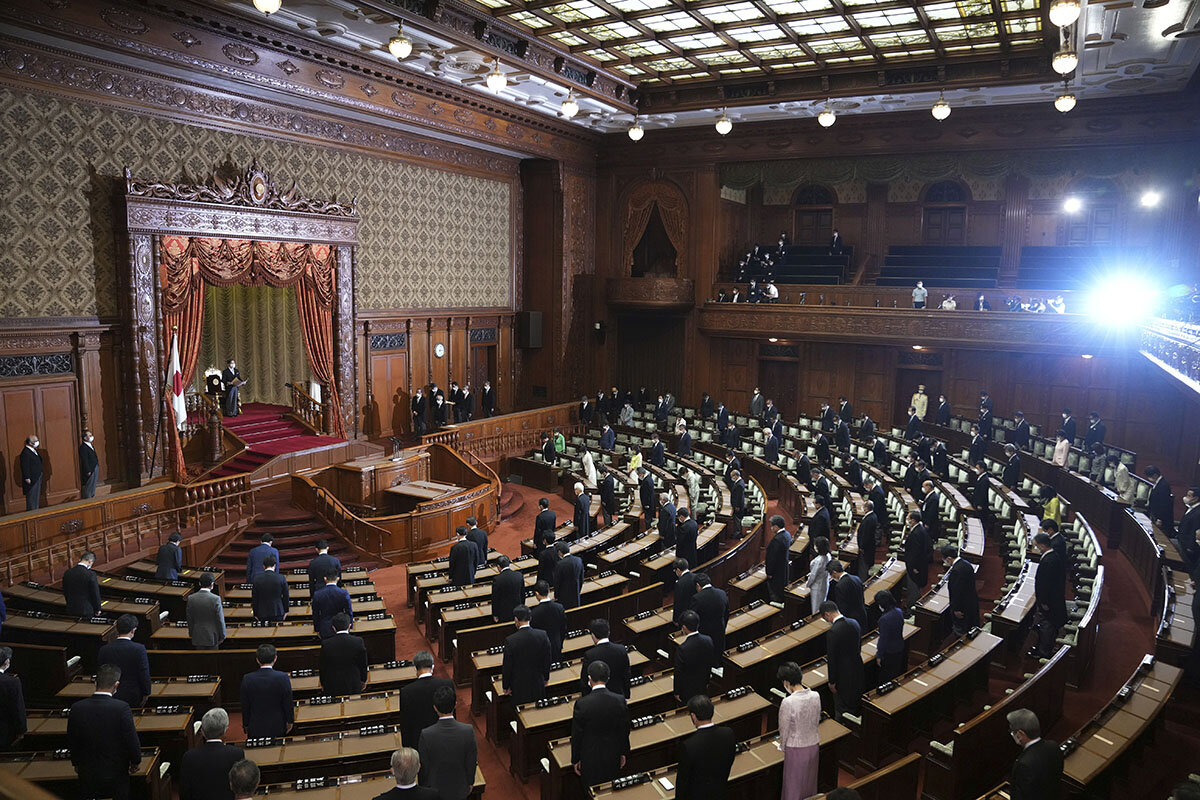
New momentum
While progress in local and upper house elections is slow, Japan’s powerful lower house is worse. Female lawmakers constitute only 9.9% of the lower house, compared with 8.4% in 1946, the year after U.S. occupation authorities granted suffrage to Japanese women.
“What on earth has Japan been doing for the past 76 years?” asks Mitsui Mariko, a women’s policy researcher who founded the Alliance of Feminist Representatives 30 years ago. “It’s more than scandalous.”
Japan has made some efforts to boost women’s participation in politics, but critics say these programs have been overly timid and fail to tackle the gender imbalance head-on. This includes the 2001 creation of a government office known in English as the Gender Equality Bureau, though it’s worth noting the phrase “gender equality” does not appear in the office’s Japanese name, which literally translates to Men and Women Joint Participation Bureau.
Former Suita city council member Nakamoto Michiko says “more women continue to work after marriage these days, and men see more female peers in the same position,” but politics is lagging behind.
Budding enthusiasm for governance – and impatience with the pace of progress – could help change that, she adds.
Ms. Nakamoto, who also attended the July camp, launched consulting group Colorful Women’s Half with a friend last year to help more women win seats in local legislatures.
“We’ve seen rising momentum, which did not exist a decade ago,” says Ms. Nakamoto.
This momentum is visible in the uptick in media coverage of women’s political representation, Ms. Nakamoto says, as well as in growing public outrage over sexism. More women are taking their frustration to the streets, working together to raise awareness about patriarchal norms in Japanese politics and society.
Across Japan, for instance, women have organized monthly “Flower Demo” rallies against sexual violence for the past three years. Last year, Tokyo Olympics President Mori Yoshiro, a former premier, was forced to quit after sparking anger at home and abroad with sexist remarks that women talk too much.
Finding success
Yamada Yuko is one of many women whose political careers and activism began after the 2011 Fukushima meltdown, which inspired mothers across the country to become more involved in education, health, and food safety due to concerns about the effects of radiation on their children. She says it’s been a career defined by cooperation.
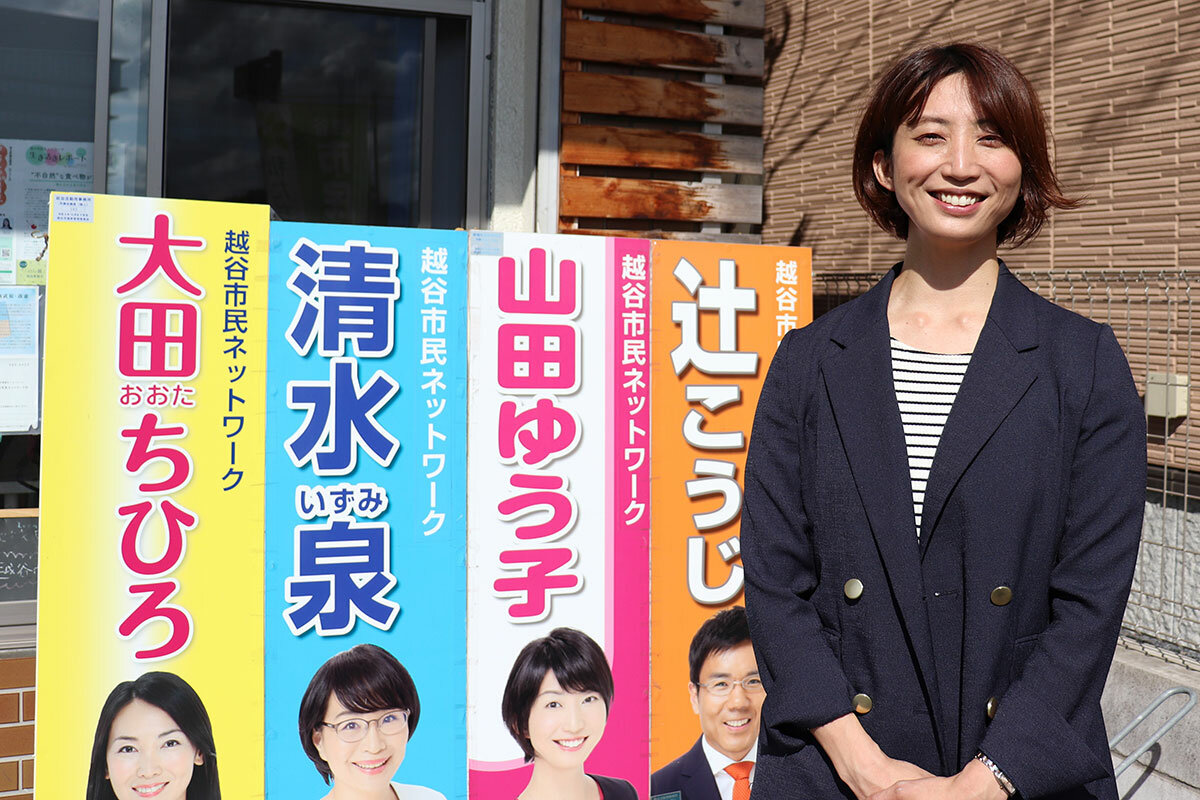
In the wake of the meltdown, she and her friends teamed up with activists, parents, and local officials to deal with health and safety challenges. Then, in 2014, she attended a meeting of the Angry Women’s Club, where those who were fed up with male-dominated politics gathered to share their frustrations and turn that outrage into action.
A year later, she ran for office during nationwide local elections and clinched a city council seat in Koshigaya, a suburb of Tokyo. The mother of two was later reelected with the second largest vote tally in 2019. Both campaigns were backed by a powerful network of mothers.
“I had never thought about becoming a politician,” says Ms. Yamada, who also serves as the co-leader of the Alliance of Feminist Representatives. “It was an extension of civic activities.”
Koshigaya now has 10 female councilors, including Ms. Yamada, representing 31% of the 32-member assembly, a relatively high percentage in Japan.
Advocates say having more women in politics helps strengthen the city’s democracy, and means Koshigaya is better poised to tackle issues including domestic violence and sexual assault.
Barriers to entry
More women are interested in running for elected office, but they still face many intractable problems such as sexism and harassment. A government survey last year found 57.6% of the female local assembly members polled said they had been sexually harassed or intimidated by voters, supporters, and/or fellow members.
Ms. Mitsui, the women’s policy researcher, says the biggest obstacle to female candidates in national elections is Japan’s single-seat constituency system that favors major parties. Many seats have long been held by older men in the ruling Liberal Democratic Party. Of the 262 LDP lawmakers in the lower house, there are only 20 women.
“Japan should adopt a proportional representation election system instead” to reflect views of women and minorities, Ms. Mitsui argues. Such a system would boost opportunities for candidates endorsed by smaller parties, and Ms. Mitsui says the countries ranking as most equal in the Global Gender Gap index have each adopted some kind of proportional representation system.
There has also been a growing call to introduce a quota system in national elections. One of the major advocates is the main opposition Constitutional Democratic Party of Japan (CDPJ).
The party lost six seats in the July upper house election. But of the 17 candidates elected, nine are women.
“We believe there are more obstacles to women’s participation in politics than men’s. So we will remove them and provide support for female candidates,” CDPJ President Izumi Kenta told a news conference in late July.
For Ms. Yoshii, the mother of two grown daughters who lost the Miyoshi council election, participating in the academy’s political training camp led to soul searching.
Ms. Yoshii realized that, during her campaign, she was frequently worried her words could make her father lose face or cause trouble for her elder brother.
“In retrospect, I still adopted a very reserved attitude even though I was running for office,” she recalls. “I should have trusted myself more. It’s OK to express myself more freely.”

Points of Progress
Tiger births and Benin Bronzes: Restorations of nature and art
Progress in our news roundup means a return to the past. That includes higher tiger counts in Nepal, and the Smithsonian’s policy of openness toward giving back artifacts to their origin communities.
Tiger births and Benin Bronzes: Restorations of nature and art

A step taken in a positive direction may be scrutinized for whether it goes far enough, especially when the decisions are made at an organization of the size and scope of the Smithsonian Institution.
1. United States
The Smithsonian Institution set new standards for returning items acquired unethically. Most museums have long operated under the assumption that legal possession was enough justification for holding items that were stolen or acquired under duress. In a push for a more ethical and culturally sensitive collections policy, the Smithsonian adopted new guidelines for returning or sharing ownership of artifacts with their origin communities. As one of the biggest players in the field, the Smithsonian is setting an important precedent with its commitment to responsible restitution, observers say.
Earlier this summer, the Smithsonian approved the return of 29 of its famous Benin Bronzes, stolen by British soldiers in the late 1800s, to Nigeria. But it’s not always clear which artifacts were stolen, and the new guidelines don’t include a systematic review of all 157 million objects across 21 museums.
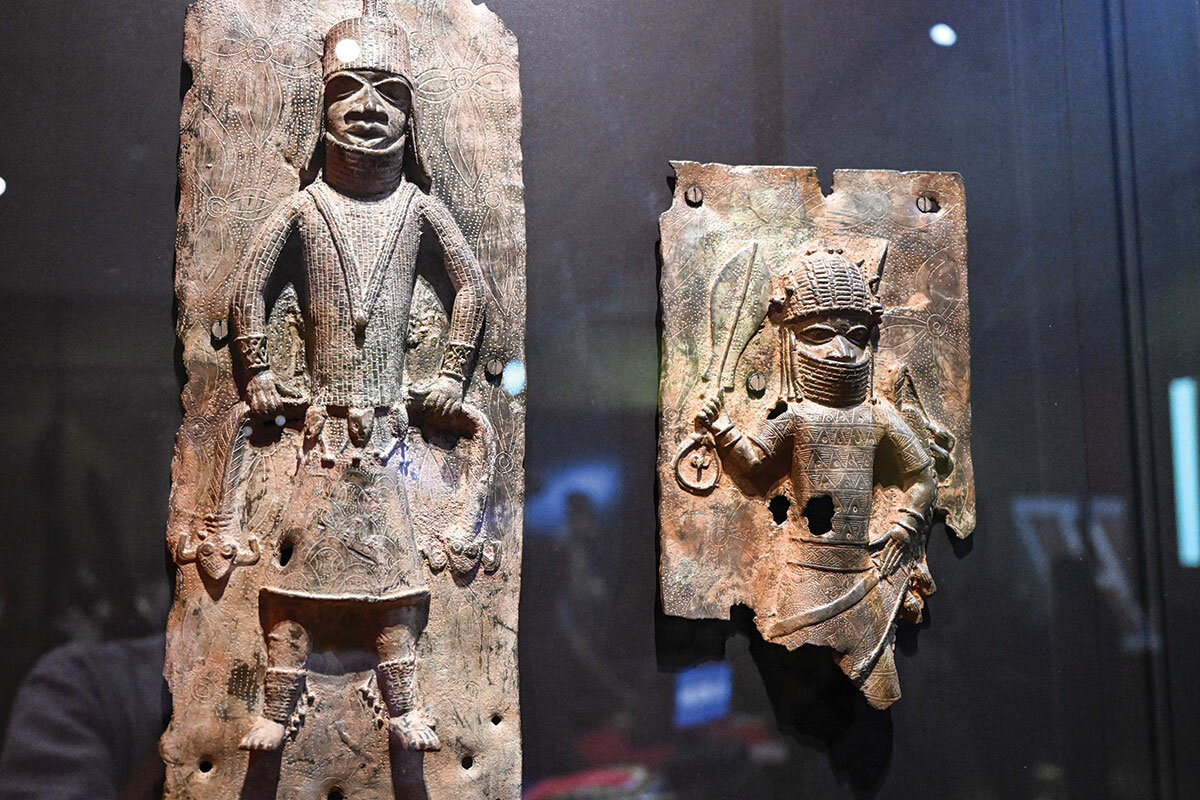
“The notion is to say, when we’re doing exhibitions, when we’re bringing in new collections, let us look at it through an ethical lens,” said the museum’s secretary, Lonnie G. Bunch III. “Or, of course, if we hear from nations or communities about things, that will also trigger the kinds of research that will really allow us to make decisions.”
Sources: The New York Times, The Washington Post
2. Andorra
Civil marriage rights were extended to same-sex couples in Andorra. Lawmakers in the tiny, independent principality wedged between France and Spain unanimously approved the new family code, which grants gay and lesbian civil partnerships the same legal rights as heterosexual marriages. Andorra joins a growing list of at least 28 countries to recognize marriage rights for same-sex couples.
The updated family code also adds rights for all couples regarding alimony and no-fault divorces. “Today we are voting on a law for everyone,” said Carles Enseñat, president of Andorra’s Democratic Parliamentary Group, before the vote. “[It is] a law of a modern country that ensures the free development of citizenship and bases its success on the most primordial organizational nucleus – the family – with all its diversity.”
Sources:Los Angeles Blade, Thomson Reuters Foundation
3. Cameroon
Refugees in Cameroon are creating “eco-charcoal” from biomass, reducing tree felling and landfill waste. Firewood is the most commonly used cooking fuel in sub-Saharan Africa. But an influx of some 60,000 refugees fleeing Boko Haram in Nigeria has put pressure on limited resources shared by local residents and those inside the Minawao refugee camp. So in 2017, the Lutheran World Federation launched an initiative to support the production of eco-charcoal from organic household waste, like corncobs, rice husks, and groundnut shells. So far, around 8,000 households have been trained to make the alternative fuel.
At the Minawao eco-charcoal facility, cooperative members first toast the biomass in a metal barrel, then grind and mix it with water to create a paste that is compressed into bricks and balls. After drying in the sun, the eco-charcoal is ready to sell. The cooperative produces 200 kilograms (440 pounds) of the briquettes per day, with the help of 60 members who are paid with a stipend and their own eco-charcoal supply. Finances are tight, and the group has had to be creative about finding sources of biomass, but those involved call the initiative “a lifeline for survival.”
Source: Mongabay
4. United Arab Emirates
The world’s largest vertical farm opened in Dubai. The United Arab Emirates’ arid climate means the country imports around 90% of its food. Vertical farming, which dates back to ancient Babylon but has gained new momentum in recent decades, is offering hope for local produce.
Dubbed Eco 1, the new 330,000-square-foot hydroponic farm is set to produce over 2 million pounds of leafy greens each year. The facility automates lighting, humidity, and nutrients, avoiding pesticides while using 95% less water than conventional farms. That’s thanks to a closed-loop irrigation system that captures and recycles evaporated water.
The farm is the result of a partnership between Crop One, a Boston-based vertical farming company, and Emirates Flight, the catering arm of the Emirates airline. The idea is gaining steam in other emirates, too: Abu Dhabi recently invested $100 million to study and expand indoor farming.
Sources: Fast Company, Interesting Engineering
5. Nepal

Nepal planned to double its tiger population – but tripled numbers instead. Twelve years ago, the country was home to a mere 121 Panthera tigris. That year, Nepal and 12 other tiger range countries agreed to bring numbers up twofold by 2022, the next Year of the Tiger in the traditional Chinese calendar. Last month, government officials announced a current count of 355 tigers, just 45 shy of the country’s estimated capacity for the species.
Some of that increase can likely be attributed to improvements in the way animals are counted. But experts see undeniable conservation progress, with ripple effects for other species as well as humans. “When we talk about protecting tigers, you’re really talking about protecting the environment that people also need to survive and live a better life,” said Dale Miquelle, tiger program coordinator for the Wildlife Conservation Society.
Source: Mongabay


Books
Audiobooks to thrill, delight, and spread hope
Humor, inspiration, and hope resound throughout a quartet of outstanding audiobooks. Listening to stories evokes the days of radio plays or campfire storytelling, making the experience immediate and absorbing.

- Quick Read
- Deep Read ( 3 Min. )
-
By Rochelle M. O’Gorman Contributor
The ability to see humor in any situation is a gift. Four authors tap into quirky characters and amusing circumstances in these four recommended audiobooks.
Two of the books, a novel by Native American writer Louise Erdrich and a memoir by Chinese Canadian comic Simu Liu, are read by the authors themselves. They bring an unmatched authority and authenticity to the recordings.
Listening to these audiobooks offers an opportunity to enter the stories by a different route than reading words on a page. Instead, the aural landscape envelopes us and carries us deeper into our imaginations.
Audiobooks to thrill, delight, and spread hope

Whether you’re in the mood for science fiction with heart, a memoir that uplifts, a celebration of books and reading, or a story about a family’s struggle to connect, these four titles are worth a listen.
“Project Hail Mary” by Andy Weir
Narrated by Ray Porter; Audible Studios; 16 hours
Andy Weir delivers an inspiring and suspenseful interstellar thriller in which a confused man, Ryland Grace, awakens on a spaceship not knowing his identity or purpose. As our intrepid and good-natured astronaut comes back to life, he slowly remembers his raison d’être – which is only to save all humankind as the sun is slowly devoured by “astrophage,” a microscopic life-form.
Hard-core science fiction fans should eat up this tale of adventure and hope, masterly read by Ray Porter, who conjures a variety of accents as well as giving voice to a realistic protagonist whose optimism (or despair) is heard in his voice. Especially clever are interactions with a delightfully complex alien creature that communicates through musical notes. Grade: A+
“We Were Dreamers: An Immigrant Superhero Origin Story” by Simu Liu
Narrated by author; HarperAudio; 8 hours

Simu Liu, star of Marvel’s first Asian superhero movie, “Shang-Chi and the Legend of the Ten Rings,” is a convivial narrator who draws us into his life with an easy, conversational manner and charming self-deprecation. Raised in Canada by engineer parents, the Chinese-born Liu speaks candidly of the difficulty in both assimilating to a new country and navigating his way through a rocky relationship with parents whose traditional ways clashed with Liu’s Western experiences.
His was a long and unlikely slog from business school to acting jobs found on Craigslist and birthday party gigs as Spider-Man, to finally, international fame. Liu captivates with his sturdy optimism and his ability to see humor in every situation. Grade: A
“The Sentence” by Louise Erdrich
Narrated by author; HarperAudio; 12 hours
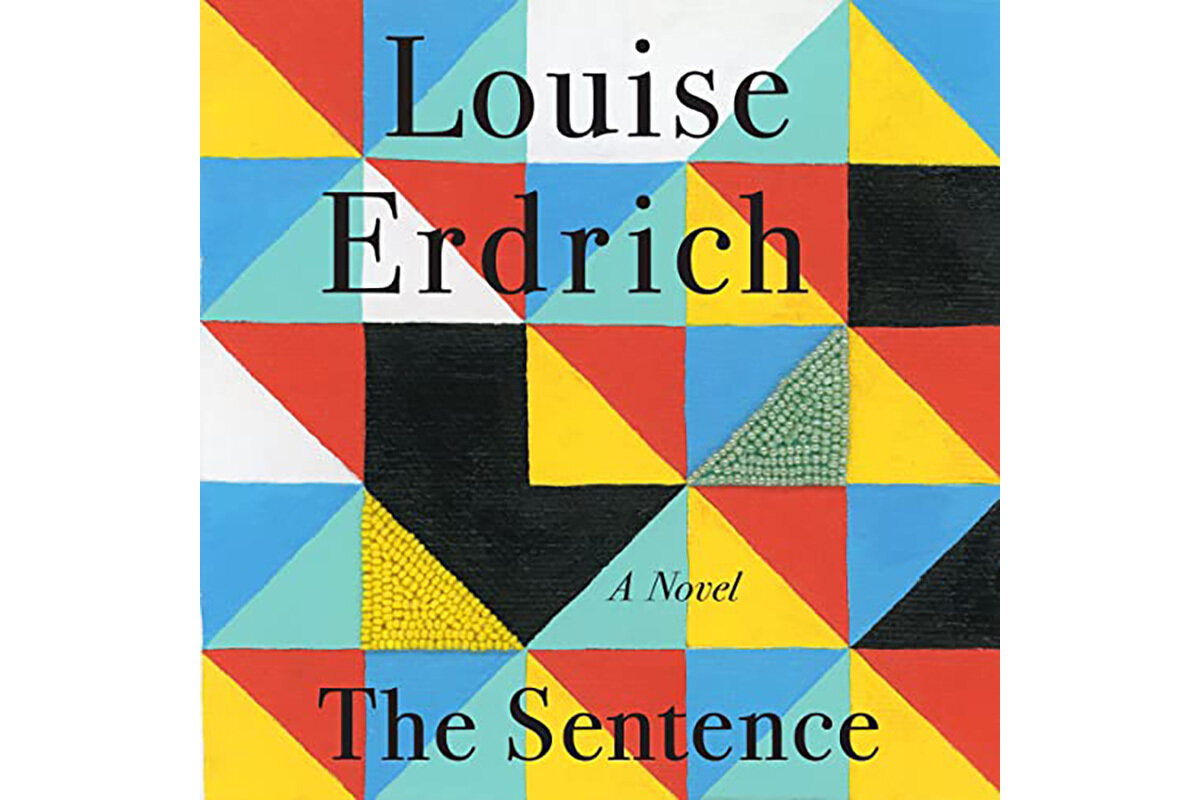
Books are at the heart of this engrossing and poignant tale told by Tookie, a Native American woman living in Minneapolis. Louise Erdrich, in her pleasant, low voice, delivers the humor and consternation that round out this character-driven tale. Listeners can chart Tookie’s personal growth, from the laughable crime caper that lands her in jail to the books that give her both education and purpose. Tookie delights us with observations about the pandemic, social injustice, love, motherhood, the ghost that is both haunting and annoying her, and an unadulterated love of the written word. Grade: A-
“French Braid,” by Anne Tyler
Narrated by Kimberly Farr; Random House Audio; 9 hours

Anne Tyler, known for stories in which quirky characters find a way to connect to those around them, somewhat misses the mark with her latest endeavor. In it, a seemingly close-knit family never quite comes together. While she cleverly builds the rationale for their inability to communicate, “French Braid” lacks the sparkle that usually permeates her novels.
Narrator Kimberly Farr clearly identifies each character using changes in accent, timbre, and pacing. Both Farr and Tyler are at their best delivering the inner thoughts, frustrations, and sly humor of the main character, Mercy Garratt, a woman trapped in her matriarchal role by both family ties and custom. Grade: B
Other headline stories we’re watching
(Get live updates throughout the day.)The Monitor's View
A great rethink on student debt
- Quick Read
- Deep Read ( 3 Min. )
-
By the Monitor's Editorial Board
President Joe Biden is expected to announce a decision this week to either extend a pause in repayments of federal student loans or cancel a portion of the debt. He may do both.
The tangible prospect of debt cancellation has renewed a larger debate about how societies balance the values of civic equality and individual responsibility.
In response to the current debate, a growing list of companies is helping employees to use a tax benefit to pay off student loans. Since 2016 more than 90 apps have been launched to help people locate scholarships to attend a school or manage how they repay their loans. The U.S. Education Department is trying to find a formula tying the pace of loan payments to borrowers’ incomes.
Many of these initiatives point to the ability of borrowers to take new approaches to using debt for education. Higher education itself begins with the individual cultivation of character and promise. A great rethinking of student debt is surely needed.
A great rethink on student debt

Forty-three million borrowers owe the U.S. government $1.62 trillion in student debt, according to federal statistics. In March 2020, federal pandemic relief legislation suspended repayment. That pause is set to expire Aug. 31. President Joe Biden is expected to announce a decision this week to either extend it or cancel a portion of the debt owed by students or their parents. He may do both.
The grace period has already been extended six times, twice during the Trump administration and four times since. But this round is different. The White House has never waited this close to the deadline to reveal its intentions. That has left borrowers wondering if they will soon face monthly payments again – or if they will suddenly be forgiven $10,000, a figure Mr. Biden has often endorsed.
The tangible prospect of debt cancellation has also renewed a larger debate about how societies balance the values of civic equality and individual responsibility.
Democratic Sen. Michael Bennet of Colorado suggests that a focus on student debt is too narrow. In a recent Senate floor debate, he said, “An across-the-board cancellation of college debt ... offers nothing to Americans who paid off their college debts, or those who chose a lower-priced college to go to as a way of avoiding going into debt or taking on debt. Really importantly, it ignores the majority of Americans who never went to college, some of whom have debts that are just as staggering and just as unfair.”
The bigger question, he argued, is “how to create a pathway to economic security for every American.”
Still, student debt levels do seem staggering. In the past two decades the cost of higher education has risen about 200%. American families have struggled to keep pace. Student debt has risen 600% during the same period. The average federal student loan balance is $37,667. That cost, together with rapid changes in the nature and needs of the workplace, has frayed the underlying calculation of higher education: that investing in a college degree ensures a more prosperous future.
In response to the current debate, a growing list of companies is helping employees to use a tax benefit to pay off student loans. Since 2016 more than 90 apps have been launched to help people locate scholarships to attend a school or manage how they repay their loans. The U.S. Education Department is trying to find a formula tying the pace of loan payments to borrowers’ incomes.
Many of these initiatives point to the ability of borrowers to rethink their approach to debt for education. One empowering quality is gratitude.
“While gratitude may seem like a soft skill to integrate into finances,” wrote Melanie Lockert in an essay for The College Investor, describing her approach to paying down her student loans, “it can completely change your money mindset and the way you spend money, hold on to money, make money, and more.”
Another approach is to see debt as not a trap but as an opportunity to change habits. “Taking out a loan is a choice, and personal responsibility shouldn’t be supplanted by taxpayer bailouts,” argued Matthew Noyes, who graduated from the State University of New York at Albany. In an essay for the Foundation for Economic Education, he described paying off $27,000 within a year of graduating by taking on extra work and being frugal.
The debate over student debt may lead Americans to find new models for safeguarding access to college. Higher education itself begins with the individual cultivation of character and promise. A great rethinking of student debt is surely needed.

A Christian Science Perspective
Each weekday, the Monitor includes one clearly labeled religious article offering spiritual insight on contemporary issues, including the news. The publication – in its various forms – is produced for anyone who cares about the progress of the human endeavor around the world and seeks news reported with compassion, intelligence, and an essentially constructive lens. For many, that caring has religious roots. For many, it does not. The Monitor has always embraced both audiences. The Monitor is owned by a church – The First Church of Christ, Scientist, in Boston – whose founder was concerned with both the state of the world and the quality of available news.
Love myself? Is that even possible?
- Quick Read
- Read or Listen ( 3 Min. )
-
By John Biggs
Sometimes we may get caught up in unhelpful thoughts about ways we don’t measure up to some standard. But there’s actual power – life-changing, spiritual power – in knowing we’re loved and why.
Love myself? Is that even possible?
Sometimes it seems like it’s really hard to love ourselves. Now, most of us probably know we shouldn’t tell lies or spread rumors about other people. But sometimes we do listen to, or tell, not-so-nice stories about ourselves. “I’m not fast enough. I’m not smart enough. I’m not something enough.”
Well, sure. Someone out there is faster than you. Someone may be better at math, or funnier, or whatever. But believe it or not, all those “I’m nots” don’t actually constitute our identity. And remembering that, at least for me, often puts a crack in that feeling that loving myself isn’t possible.
I always appreciate the things Jesus shared because he told us that he came to speak the truth. Here’s something he said in his Sermon on the Mount, for example: “Let your light so shine before men, that they may see your good works, and glorify your Father which is in heaven” (Matthew 5:16).
To me, this says that each of us has a wonderful, unique light – our individuality, our gift to the world – and not only can we know it but we can shine it out confidently. But here’s the interesting part of what Jesus was saying – it’s in that second half. He said that when people see the good we do, it should lead them to glorify not us, but God.
Maybe that sounds kind of like a bummer. If we’re doing something good, don’t we want that to be recognized? Isn’t that part of being loved? But what’s so safe about the fact that all our good qualities point back to the divine Mind, God, is that it means they’re constant. They’re not up for grabs based on what people think about us or what we think about ourselves. And since those qualities come from an infinite source, we can’t be lacking in any area. Our spiritual identity is the “full representation of Mind,” as Mary Baker Eddy says in “Science and Health with Key to the Scriptures” (p. 591).
You could also sub in another name for God and say that our real identity is the full representation of Love. And that really starts to get us somewhere in terms of loving ourselves. If we’re the full representation of Love, then we must be loving, loved, lovable – whether or not we always feel that or believe it.
I found this out for myself one time when I went on a trip. I had been having a really hard time. I had left behind some hurt feelings and broken relationships, and I was feeling very unloved. But two weeks into my trip, I had an amazing experience early one morning on a hillside overlooking the ocean.
At first, I was yelling at God about all the things that were terrible and asking Him why He hadn’t done anything about it. But when I finally ran out of complaints, there was this space of sacred silence, and all of a sudden, I just felt loved. Profoundly, divinely loved. I knew without a doubt that I was loved. And this love was more important than any of the things I’d been yelling about; it was the reason I existed. I was healed, and I knew more clearly who I was. Not a person with disappointments and problems – I was loved.
The rest of my trip – in fact, the rest of my life – was transformed by that quiet morning. After all, you can only give what you have. So if you know you’re loved – if you know you have love – then you can freely give it. And when we do this, we feel that love come washing right back over us! You could say that knowing the fundamental spiritual fact that we’re loved creates a continuous cycle of loving and feeling loved, feeling loved and loving.
It’s never too late to love more. It’s never too late to admit that you are deeply loved. Every day, every morning, you can remind yourself: “I am loved, I am loving, I am lovely, I am lovable.” You’ll find, as I did, that it really is true.
Adapted from an article published in the Christian Science Sentinel’s online TeenConnect section, Aug. 9, 2022.

A message of love
Art endures

A look ahead
Thanks for joining us today. Come back tomorrow, Independence Day in Ukraine, where veteran correspondent Howard LaFranchi is exploring the meaning of the holiday six months into the current conflict.



